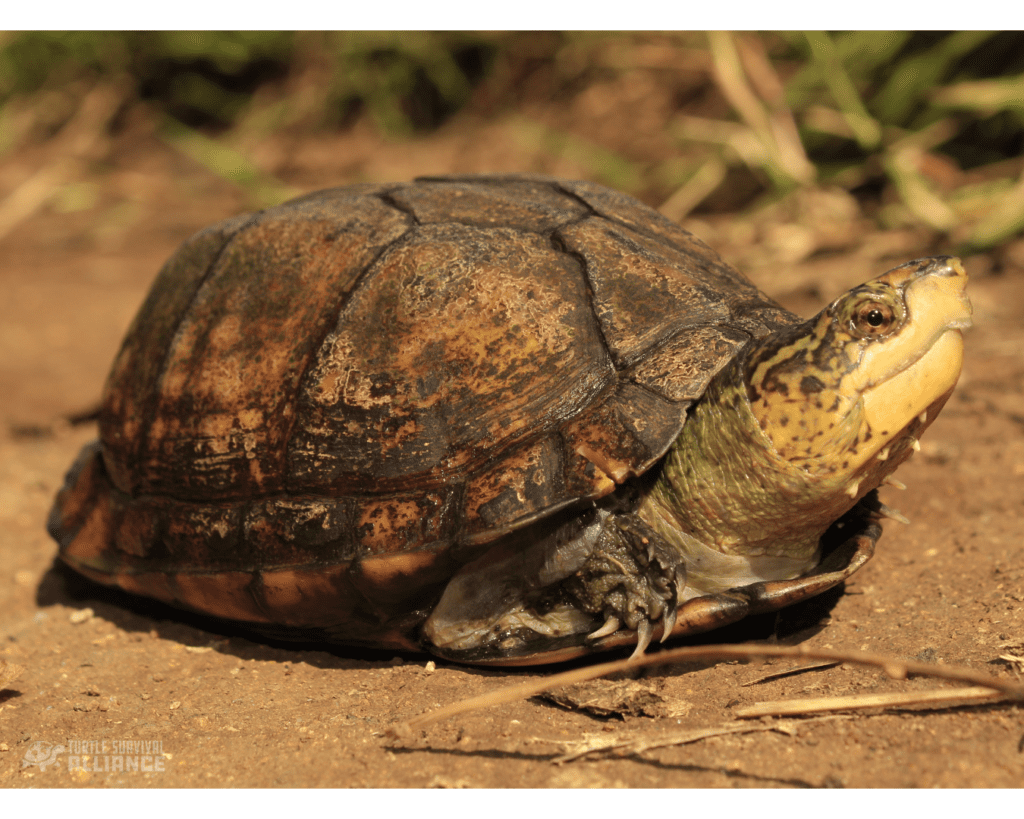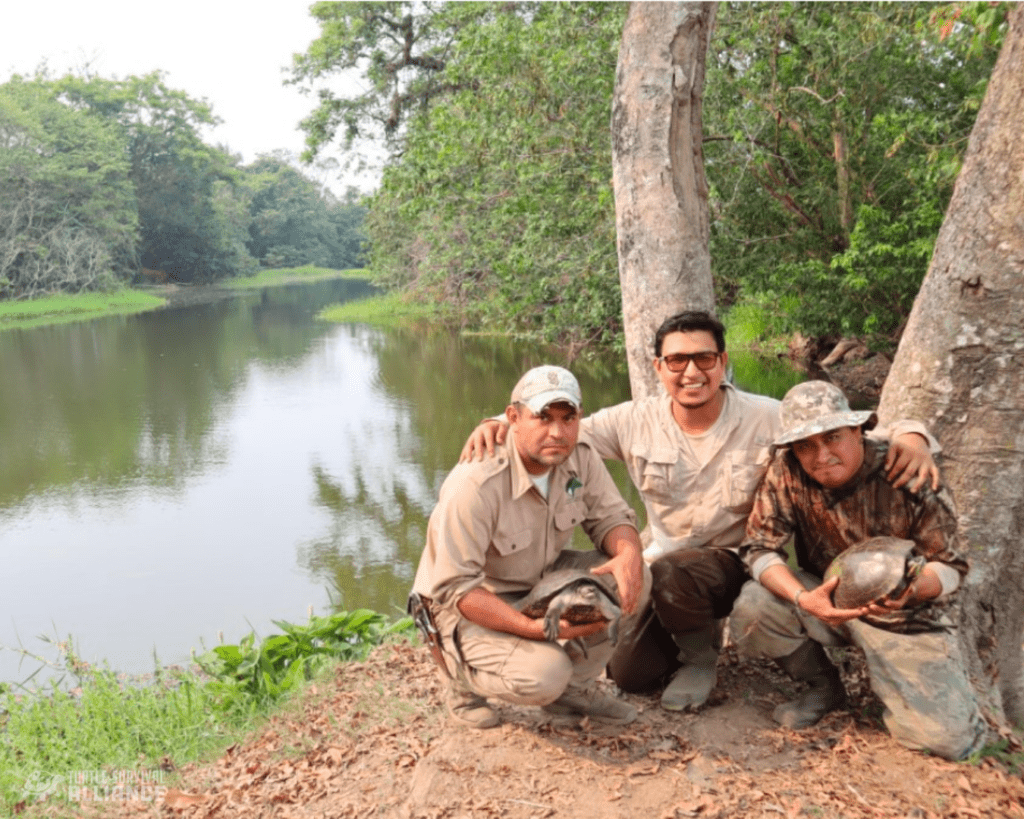Updates from the Field: Turtle Conservation in Chiapas, Mexico
By Eduardo Reyes Grajales, PhD student, Department of Biodiversity Conservation, Colegio de la Frontera Sur, San Cristóbal de las Casas, Chiapas, Mexico
The state of Chiapas is one of the most culturally and biologically rich in Mexico; however, historically, this state presents big challenges for the conservation of its flora and fauna, and turtles are no exception. In March 2023, I began a partnership with Turtle Survival Alliance, implementing various initiatives spanning from southern to northern Chiapas. This state is home to 16 continental turtles of which I have recorded 14.
My work in Chiapas this spring has allowed me to engage the community in efforts to conserve the habitat of a particular mud turtle, begin our research on one of the most endangered turtles in the world, participate in a successful webinar on the conservation of terrestrial and freshwater turtles in Mexico, and commence a study on the reproductive biology of one of the least studied turtles in Central America.
In April, I initiated contact with the honorable council of Villa Hidalgo, a village in central Chiapas, regarding the protection of a lagoon in the community. Why there? For the past five years, I have been monitoring a turtle population in that vicinity, recording over 350 individuals of the Central Chiapas Mud Turtle (Kinosternon abaxillare), a species that is only distributed in the central portion of Chiapas and a small area in western Guatemala. The central region of Chiapas is characterized by its highly productive agriculture and livestock operations. This has led to the disappearance of much of its deciduous forest, endangering the animals that inhabit the area. It is now rare to find natural localities with so many individual turtles in one place. Meetings were held to discuss designating the area around this lagoon as a community-protection zone by local agreement. The proposal was unanimously approved on April 28. To celebrate the event, a cleaning of the lagoon and a reforestation effort along its margins was organized.

At the beginning of May, we conducted our first field trip to study populations of the imperiled Central American River Turtle (Dermatemys mawii) over a ten-day period in the northern region of Chiapas. The Central American River Turtle is a fully aquatic, herbivorous species in all its size and sex categories. Unfortunately, the species is overexploited for its meat for local consumption, making it one of the world’s most critically endangered turtles. Compounding this issue, northern Chiapas faces high rates of land use change, contamination of its water bodies primarily due to livestock and agriculture, and a significant presence of non-native fish.
So, why do we study the Central American River Turtle under these conditions? First, some populations have survived under intense environmental and human pressures. Therefore, understanding the ecological patterns that individuals of the species develop to survive is key to proposing effective conservation strategies. To address this, I study the characteristics of the turtle population (e.g. number of individuals, sex ratio, and size) and the food webs to which the Central American River Turtle is linked. I employ a mixed methodology that incorporates both scientific and anecdotal knowledge from local fishermen. This combination of information has proven successful in identifying capture sites and applying non-invasive methodologies to capture the species in the large lagoons and rivers of southeastern Mexico.

Fieldwork was challenging due to the difficulties of transporting large traps and field equipment, as well as covering extensive routes of an aquatic system in temperatures reaching up to 109°F (43°C). These challenges were compounded by insecurities within the social context of southeastern Mexico, posing limitations on certain activities. Despite these obstacles, we succeeded in locating turtles! Finding more than a dozen individuals of this critically endangered species using this initial approach isn’t bad, right?
Among the 16 Central American River Turtles we captured were several large individuals exceeding 16 in (40 cm) in shell length and 51 lbs (23 kg) in weight. However, we noticed that predation pressures are very high, and we cataloged multiple individuals with significant signs of predation attempts. Despite these attempts, they continued to grow, demonstrating their resilience as survivors.
This project goes beyond studying the Central American River Turtle in this region; our aim is to replicate this study in various locations within protected natural areas. Our goal is to broaden our understanding of wild populations, identify conservation needs, and forge partnerships to safeguard these turtles and their environment.

On this trip, we not only sought out the Central American River Turtle, but also had the opportunity to record individuals of the Meso-American Slider Turtle (Trachemys venusta), Central American Snapping Turtle (Chelydra rossignonii), Northern Giant Musk Turtle (Staurotypus triporcatus), White-lipped Mud Turtle (Kinosternon leucostomum), Furrowed Wood Turtle (Rhinoclemmys areolata), and some curious Morelet’s Crocodiles (Crocodylus moreletii)! Additionally, we had the opportunity to interact with local communities to publicize our work, share experiences, and emphasize the importance of the conservation of tropical ecosystems.
To enhance our public engagement efforts and commemorate World Turtle Day© (May 23), the Colegio de la Frontera Sur organized a webinar titled “Challenges for the Conservation of Turtles in Mexico.” This event featured the participation of national experts from the Universidad Nacional Autónoma de México (UNAM), Universidad de Juárez Autónoma de Tabasco (UJAT), the Colegio de la Frontera Sur (ECOSUR), and the Secretaría del Medio Ambiente e Historia Natural del Estado de Chiapas (SEMAHN). Here we discussed the current challenges in turtle conservation in Mexico, focusing on community participation and collaboration between educational and government institutions. You can view the different participations by following the link here.
Every moment in this season served as a poignant reminder of the fragility of nature and our responsibility as human beings to protect it. Without a doubt, this year has been a great adventure filled with work to deepen our understanding of the turtles of Chiapas. We look forward to continuing this great work day by day, safeguarding their habitats, and creating synergies with local communities to promote turtle conservation in this region of Mexico.

Acknowledgments: I appreciate the valuable support of the Miguel Álvarez del Toro Zoo to carry out fieldwork, especially Ernesto E. Perera Trejo (Curator of the Crocodile Area), Ángel de la Cruz Pérez (Assistant of the Crocodile Area), and Carlos A. Guichard Romero (Operational Director). Additionally, to the honorable council of Villa Hidalgo, the Colegio de la Frontera Sur, Juan Baldovinos, Pablo Baldovinos (owner of EcoHostal Costa Verde), and Victor H. Reynoso (research professor at UNAM).
Header image: An adult female Central American River Turtle (Dermatemys mawii) collected with signs of attempted predation. All photos courtesy of Eduardo Reyes Grajales.
